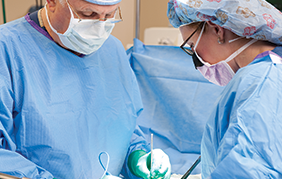Surgical options
Surgery is often the first line of treatment for many types of early stage gynecologic cancer. Our goal during surgery is to locate and remove as much of the tumor tissue as possible (called debulking) and to understand the extent of the cancer. During the initial debulking surgery, we may perform a variety of procedures, depending on the type and stage of the cancer.
If you wish to preserve your fertility, and you are an appropriate candidate, a City of Hope gynecologic oncologist will discuss fertility-sparing procedures with you.
Some of the surgical options available to gynecologic cancer patients at City of Hope include:
Robotic surgery (da Vinci® surgical system)
The da Vinci surgical system offers a minimally invasive alternative to open surgery or laparoscopy. Using da Vinci offers greater vision, precision and control for your surgeon. This procedure may also help you recover sooner, move on to additional treatments if needed faster and get back to daily life more quickly.
Lymphadenectomy
A doctor may remove lymph nodes in your pelvis as part of a hysterectomy to stage your cancer and develop a more targeted cancer treatment plan.
Omentectomy
During this surgical procedure, part or all of your omentum, a fold of fatty tissue inside the abdomen, is removed.
Pelvic exenteration
If you have recurrent or advanced cancer, pelvic exenteration may be an option. During this procedure, your surgical oncologist removes the uterus, cervix, vagina, ovaries, bladder, rectum and nearby lymph nodes.
Tissue from elsewhere in your body is used to reconstruct the vagina, and urine and stool are passed into external bags.
Radical hysterectomy
A radical hysterectomy involves removing your uterus, cervix and ovaries, as well as all of the surrounding tissue (the parametria) and the upper part of your vagina.
Total hysterectomy
This surgical procedure involves the removal of your uterus, including the cervix.
Unilateral/bilateral salpingo-oophorectomy
During a unilateral or bilateral salpingo-oophorectomy, your surgeon removes one or both of your ovaries and fallopian tubes.
